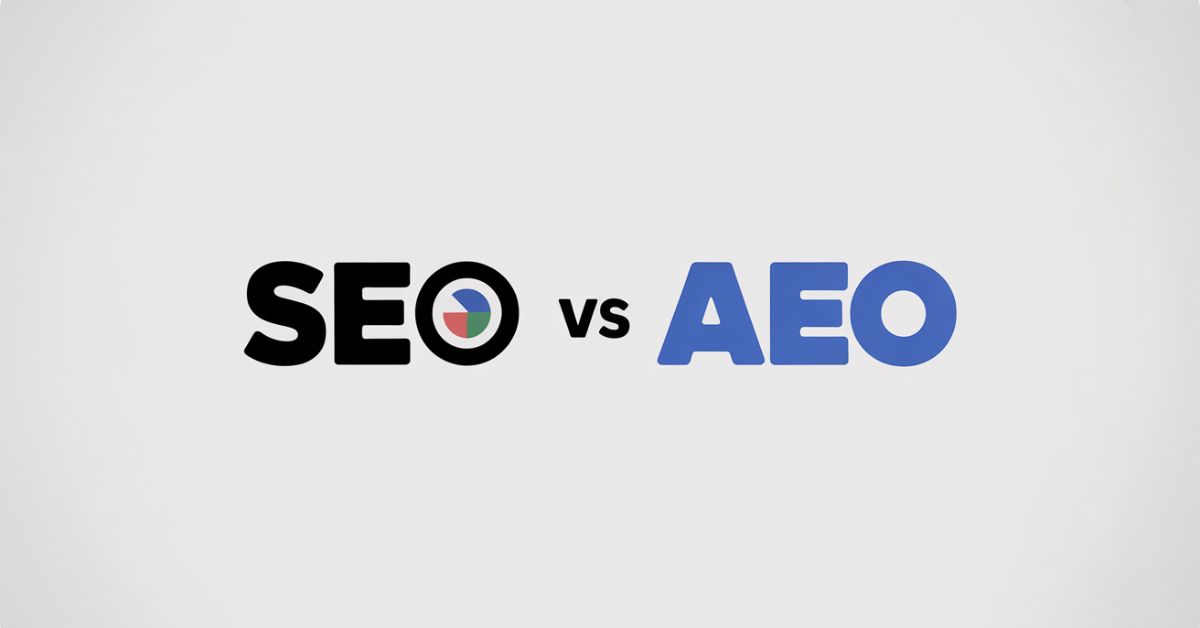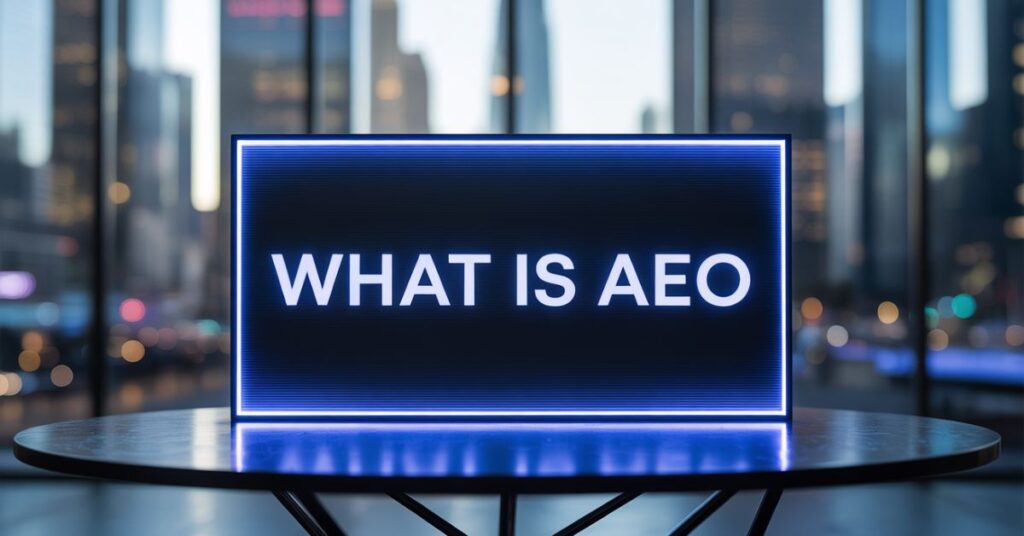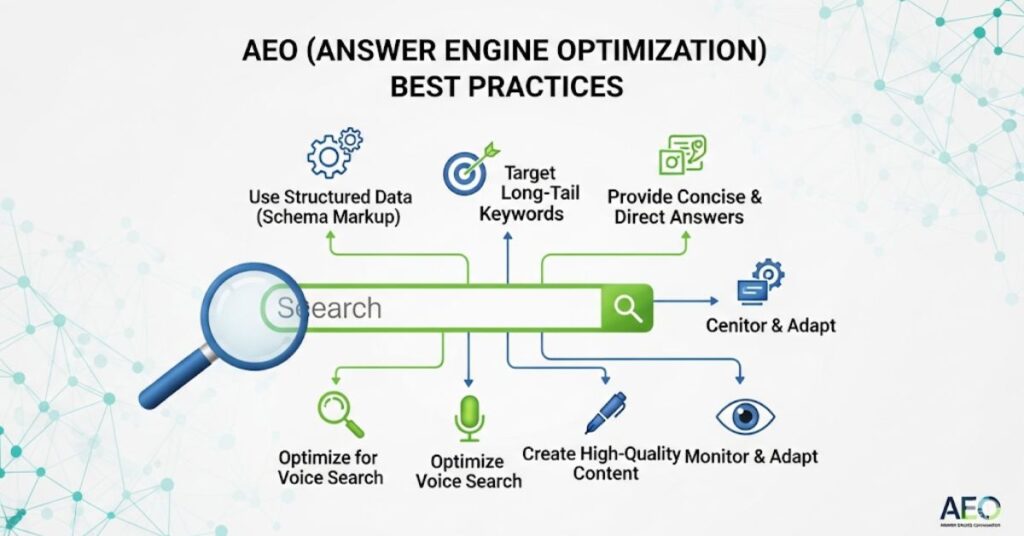In the world of digital marketing, staying visible online is crucial for any business. Traditionally, SEO, or Search Engine Optimization, has been the go-to method to achieve this. SEO focuses on making websites more attractive to search engines like Google by using keywords, backlinks, and optimized content. However, as technology evolves, especially with the rise of AI and voice search, a new player has entered the scene: AEO, or Answer Engine Optimization.
AEO is about preparing your content to be directly picked up by AI-driven tools like Google’s featured snippets, voice assistants like Alexa, and AI models like ChatGPT. Unlike SEO, which aims to get users to click on links, AEO strives to provide instant answers to users’ questions. In this article, we’ll explore the core differences between AEO and SEO, how they work together, and why understanding both is essential in 2025 and beyond.
What Is SEO?
Search Engine Optimization (SEO) is the practice of improving your website so it ranks higher on search engine results pages (SERPs). The goal is to drive organic (non-paid) traffic to your website. SEO includes various techniques like:
- Keyword Optimization: Using relevant words and phrases your audience is searching for.
- Backlink Building: Getting other reputable websites to link to your site.
- Technical SEO: Improving website speed, mobile-friendliness, and proper site structure.
- Content Creation: Writing high-quality, valuable content that meets users’ needs.
For example, if someone searches for “best Italian restaurants in New York,” websites with strong SEO will appear at the top of the results. These websites likely have the right keywords, fast loading speeds, good backlinks, and relevant content.
SEO has been the standard for online visibility for over two decades. It works well for attracting clicks and engaging users through websites and blogs. However, with more people using AI and voice-based search, traditional SEO alone may no longer be enough.
What Is AEO (Answer Engine Optimization)?
AEO focuses on optimizing your content so it can be picked up by AI-driven tools that provide direct answers to users. Instead of leading users to click a link, AEO aims to give them the exact information they need, right on the search page or in a voice response.
Key characteristics of AEO:
- Answer-Focused Content: AEO content is designed to answer specific questions clearly and concisely.
- Structured Data: Using schema markup to help search engines understand your content.
- Conversational Tone: Content that mimics natural speech, ideal for voice search.
- Snippets and FAQs: Including well-structured sections that can be pulled directly into AI-generated responses.
AEO is particularly important for devices and platforms that prioritize voice and direct answers. For instance, if someone asks Siri, “What’s the capital of Australia?”, AEO-optimized content will be the one that Siri pulls the answer from, which is “Canberra.”
As AI tools like ChatGPT, Perplexity, Gemini, and voice assistants become more common, AEO is becoming a crucial part of modern digital marketing.
Core Differences Between AEO & SEO
| Aspect | SEO | AEO |
| Objective | Rank high on search results to attract clicks | Provide instant, direct answers |
| User Intent | Broad searches, research, or commercial intent | Specific questions with quick-answer needs |
| Content Style | Long-form, keyword-focused | Concise, conversational, structured |
| Primary Tools | Keywords, backlinks, technical improvements | Structured data, schema markup, natural phrasing |
| Outcome | Website visit, user engagement | Zero-click result, featured snippet, voice response |
These differences highlight how SEO and AEO serve different search behaviors. While SEO is great for content-heavy queries that require exploration, AEO excels at short, question-based queries.
Why AEO Matters in 2025
The way people search for information is changing rapidly. AI tools and voice search are now influencing a large portion of online activity. Studies show:
- Around 40% of younger users now use AI tools like ChatGPT or Gemini instead of traditional search engines.
- Zero-click searches, where users get answers directly without clicking, are estimated to make up over 60% of Google searches.
- Businesses that rely only on SEO are seeing declines in organic traffic because their content isn’t being picked up by AI tools.
This shift means AEO is no longer optional. To stay visible in 2025, brands must adapt their content for both search engines and AI answer engines. This includes using schema markup, writing clear answers, and ensuring their content is trusted and cited by AI tools.
How AEO and SEO Complement One Another
While AEO and SEO are different, they’re not enemies. In fact, they work better together. A strong SEO foundation ensures your website is fast, reliable, and rich in content. AEO builds on this by making specific parts of your content easier for AI and search engines to use as direct answers.
For example:
- A blog post written for SEO can include an FAQ section optimized for AEO.
- A product page can use structured data to describe specifications in a way that helps AI pull those details.
- A long-form article can begin with a short, clear summary that serves AEO goals.
Together, AEO and SEO increase your chances of visibility across traditional search results and modern AI-powered responses.
Implementation Tips
To get the best of both SEO and AEO, you need a well-rounded implementation strategy. Here’s how you can do that in a more actionable and detailed way:
1. Conduct Hybrid Keyword Research
Start by identifying a mix of both traditional keywords and question-based queries. Use tools like:
- Google Keyword Planner for high-volume terms.
- AnswerThePublic, AlsoAsked, and Semrush’s Question Filter to find questions users frequently ask.
- Look at Google’s “People Also Ask” and “Related Searches” to discover answer-oriented queries.
This helps you target long-tail keywords for SEO while preparing your content to address specific questions for AEO.
2. Structure Content for Dual Use
Design content that works for both ranking and answering:
- Use clear headings (H2, H3) for each section.
- Use bullet points, numbered lists, and short paragraphs to improve readability.
- Start sections with a concise answer followed by a detailed explanation to serve both AEO and SEO.
- Ensure your content flows naturally but is easy to skim for search engines and AI tools.
3. Add FAQs and Snippet Blocks
Insert a FAQ section at the end of each blog post or landing page:
- Answer in 2–3 short sentences per question.
- Use direct, simple language.
- Format these sections with appropriate schema markup to make them eligible for Google’s rich results.
- Also, include definition-style content and summary boxes to increase snippet chances.
4. Use Structured Data Markup
Schema markup is essential for helping AI and search engines understand your content:
- Use FAQPage, HowTo, Product, or Article schema where relevant.
- Validate your markup using Google’s Rich Results Test Tool.
- Consider tools like Schema.org, Yoast SEO, or RankMath to help automate structured data on your pages.
Structured content increases your chances of appearing in featured snippets, voice results, and AI summaries.
5. Focus on EEAT (Experience, Expertise, Authoritativeness, Trust)
Google and AI tools value quality content created by real experts:
- Add author bios and mention credentials where applicable.
- Link to credible sources and data-backed claims.
- Regularly update content to maintain accuracy and freshness.
- Show social proof, reviews, or testimonials to build trust.
Strong EEAT signals not only improve SEO rankings but also increase your content’s chance of being cited by AI answer engines.
6. Track Both SEO and AEO Performance Metrics
You need to monitor both types of optimization to understand what’s working:
- Use Google Search Console to track keyword rankings, impressions, and clicks.
- Google Analytics 4 (GA4) can show user behavior, time on page, and engagement.
- Manual logging or spreadsheets can track if your content is cited by tools like ChatGPT, Gemini, or Perplexity.
- Tools like SurferSEO, InLinks, or Frase can help monitor your content’s optimization level for both AEO and SEO.
Tracking AEO can be tricky, but regular checks on how often your content is referenced in AI tools will give you useful insights.
How AEO Helps During Google Core Updates
Google Core Updates often bring ranking instability for websites. These updates reward high-quality, authoritative content and penalize outdated or unhelpful content. AEO can play a vital role in staying visible during such updates.
1. Aligned with Helpful Content Updates
AEO content is designed to directly help users by answering their questions. This aligns with Google’s priority to rank helpful, people-first content.
2. Maintains Visibility in Zero-Click Spaces
Even if your site drops in traditional rankings, AEO-optimized content can still appear in AI summaries, featured snippets, and voice answers.
3. Encourages Better Structure and Schema
AEO promotes structured formatting and schema usage, which helps Google understand and rank your content more accurately.
4. Boosts EEAT and Trust Signals
AEO content often emphasizes expert-backed, well-organized answers, boosting your credibility and aligning with Google’s EEAT criteria.
Future Trends
As technology continues to evolve, we can expect even more changes in how people search and consume content. Some trends to watch include:
- Generative Engine Optimization (GEO): GEO takes AEO a step further by optimizing for AI-generated summaries across multiple engines.
- Multi-Platform Visibility: Content will need to be visible not only on Google, but also on AI tools, smart devices, and even AR interfaces.
- Decline of Traditional Clicks: As zero-click answers grow, content strategy will focus more on brand visibility and less on direct traffic.
- Integrated AI Marketing: Businesses will start using AI to create, test, and optimize content for both SEO and AEO.
Conclusion
SEO has been the backbone of online visibility for decades, helping websites attract visitors through organic search. But the digital landscape is evolving. With the rise of voice assistants, AI search engines, and zero-click results, AEO has become just as important.
The difference between AEO and SEO isn’t just about tactics, it’s about mindset. SEO is about ranking. AEO is about answering. Together, they create a strategy that covers every angle of the modern search experience.
To stay ahead in 2025 and beyond, businesses must embrace both. By combining the depth and reach of SEO with the precision and immediacy of AEO, you can ensure your content stand
FAQs: Is SEO Still Enough After 2025?
As digital search habits evolve, many marketers are wondering:
Q: Will I need to focus more on AEO than SEO after 2025?
A: Not necessarily more, but differently. SEO will still matter for in-depth articles, product discovery, and long-tail visibility. But AEO will become increasingly important for quick, AI-powered answers. If you’re not optimizing for both, you’re risking invisibility in modern search formats.
Q: Can I succeed using only SEO?
A: You might, but with limitations. If your audience is shifting toward voice search, mobile queries, or AI summaries, SEO-only strategies will miss those opportunities.
Q: Will SEO become obsolete?
A: No—but it will evolve. Expect traditional SEO to focus more on content quality, EEAT, and user intent, while AEO will lead the way in AI-generated responses and featured snippets.
Q: Should I abandon SEO and go all-in on AEO?
A: Absolutely not. The future of search isn’t either/or—it’s both. The most successful strategies will merge the strengths of SEO and AEO.



